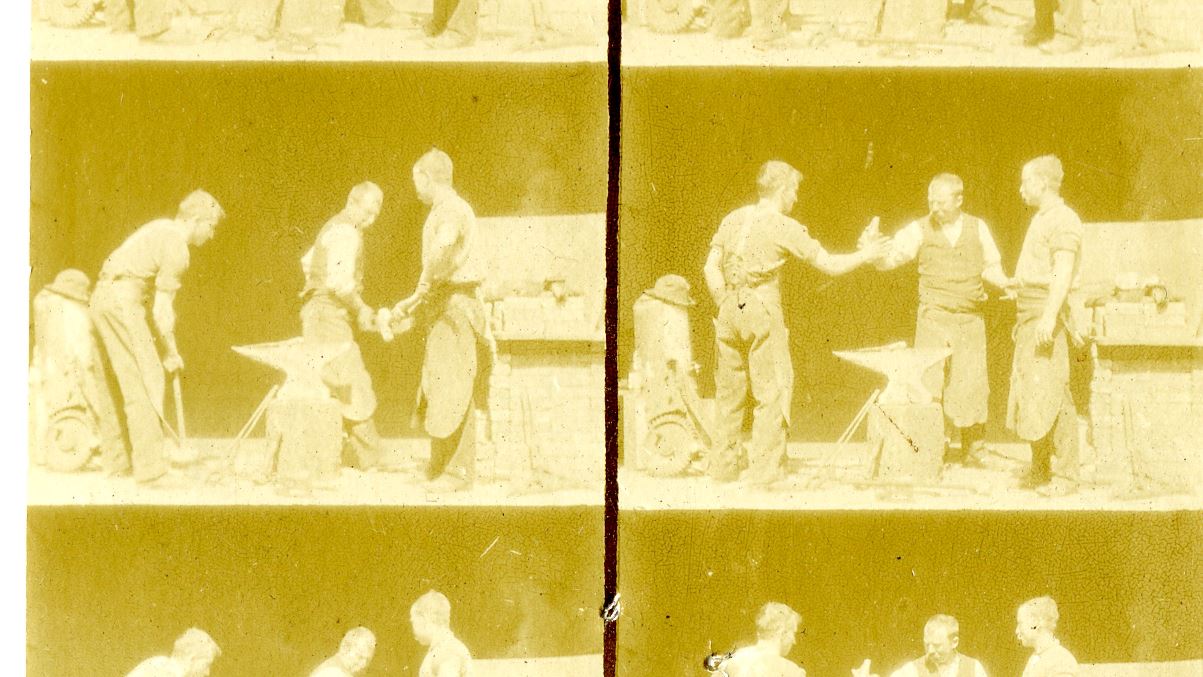Scholar at the Library of Congress Identifies the First Motion Picture Ever Copyrighted
Claudy Op den Kamp, a film scholar at the Library of Congress’ John W. Kluge Center, has solved a longstanding mystery by identifying the first U.S. motion picture ever copyrighted – “The Blacksmith Shop” by Thomas Edison.
For decades, scholars have mined copyright records at the Library — home to the U.S. Copyright Office — to piece together the story of early cinema. It has long been known that the first motion picture registration was made in 1893. But no one had been able to tie that registration to an actual motion picture title with any certainty until now.
This first film registered was inscribed in the official copyright record book only as “Edison Kinetoscopic Records.” Neither the original letter applying for the copyright nor any prints from the film were known to exist.
A lecturer in film and intellectual property at Bournemouth University in the U.K., Op den Kamp was in residence as a Kluge Fellow for six months this year. During her time at the Library, she studied the role of Librarian of Congress Ainsworth Rand Spofford in forming the “Paper Print Collection,” a collection of the rolls of photographic contact paper that the earliest filmmakers submitted to register motion pictures.
Most early films were made on nitrate stock, which is highly flammable and prone to deterioration, and when these films were first copyrighted, the Library did not have the capacity to house them safely. Nor did a category exist in copyright law for motion pictures until 1912.
Pioneering producers, starting with Edison, exposed their nitrate film negatives on rolls of photographic contact paper to register them, mostly as photographs, a category established in 1865. The Library has about 6,500 paper prints of these films — more than any other institution in the world by far.
In her extensive search, Op den Kamp consulted around 30 staff experts, current and retired; used five reading rooms; and became intimately familiar with the evolving copyright archival practices from the early days of film. All this led her to request five pallets of correspondence to Spofford from storage from the Rare Book and Special Collections Division, each containing 50 boxes, each in turn associated with 2,000 registrations.
Inside one of the boxes, Op den Kamp found a letter dated Nov. 14, 1893, signed “W.K.L. Dickson.” She knew him as the head photographer at Thomas Edison’s New Jersey laboratory at a time when Edison was racing against competitors to establish himself as the father of motion pictures.
In his letter, Dickson asked about the status of the copyright application he submitted the previous month for “Kinetoscopic Records.” To Op den Kamp’s great surprise, the letter also included 18 small images printed in two strips on a single sheet. The photographs depicted three men standing around an anvil enacting a scene from a blacksmith shop.
Dickson’s inquiries in the letter definitively identified that first copyright motion picture registration as “The Blacksmith Shop.” The scene was already known by historians, as it was the first publicly shown film using the kinetoscope. The Library of Congress added the film to the National Film Registry in 1995 as being culturally, historically or aesthetically significant. A copy of the 30-second film has been preserved by the Museum of Modern Art.
Shown to audiences in Brooklyn, New York, on May 9, 1893, a Brooklyn newspaper reported the following day, “it shows living subjects portrayed in a manner to excite wonderment.”
The Copyright Office is the principal federal entity charged by statute with the administration of the U.S. copyright law. Among other statutory duties, the Register oversees the copyright registration and recordation systems of the United States, manages statutory royalty fees totaling more than a billion dollars annually, advises Congress on domestic and international copyright policy issues, and provides support on copyright matters to courts and executive branch agencies.
The Library of Congress is the world’s largest library, offering access to the creative record of the United States — and extensive materials from around the world — both on-site and online. It is the main research arm of the U.S. Congress and the home of the U.S. Copyright Office. Explore collections, reference services, and other programs and plan a visit at loc.gov, access the official site for U.S. federal legislative information at congress.gov, and register and record creative works of authorship at copyright.gov.
###
Media Contact: Bill Ryan, Library of Congress, wryan@loc.gov
Public Contacts: Nora Scheland, U.S. Copyright Office, nscheland@copyright.gov | Mike Mashon, Library of Congress, National Audio-Visual Conservation Center, mima@loc.gov
PR 22-090
10/13/2022
ISSN 0731-3527

